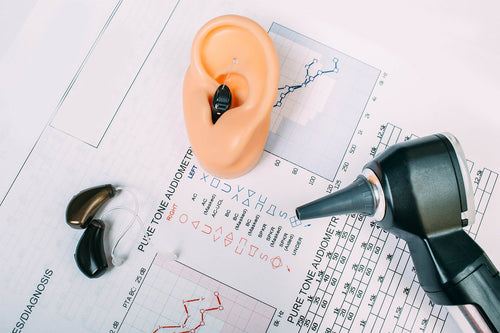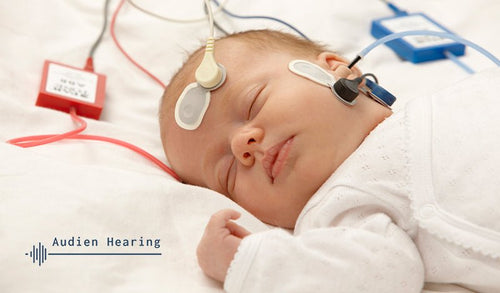
Pure tone audiometry is the primary hearing test for identifying hearing threshold levels in a patient and determining the degree, configuration, and type of hearing loss.
This provides a basis for diagnosing and managing hearing loss. Pure tone audiometry is a behavioral, subjective measurement of the patient's hearing threshold because it depends on the individual's response to pure tone stimuli.
Because of this, pure tone audiometry is only used in children and adults who are old enough to cooperate with the hearing test procedure. Just as with so many other clinical tests, the equipment, general calibration of the test environment, and the stimuli are required before the testing begins.
Pure tone audiometry measures the hearing ability threshold and doesn't test for other aspects of hearing like speech recognition and sound localization. Nevertheless, the pure tone audiometry test has so many benefits over other types of hearing tests.
In this article, we'll have a look at pure tone audiometry in relation to conductive hearing loss. How does pure tone audiometry test for conductive hearing loss? Such questions and more will be answered.
What Does Pure Tone Audiometry Do?
Just as its name, the pure tone audiometry test utilizes pure tones to find out if a patient can hear all frequencies in the audible spectrum.
This is called a subjective test, and it is implemented via a device called the audiometer.
The audiometer can register the hearing test results in an audiogram and then shows if the patient's hearing is damaged with regards to sound transmission in the middle ear, which is termed conductive, or if the inner ear is affected - sensorineural hearing loss.
This makes identifying the most suitable treatment for the problem easier and faster.
Pure tone audiometry provides the physician with specific thresholds. It utilizes frequency-specific pure tones to make place for specific responses to identify the configuration of hearing loss in a patient.
Because pure tone audiometry works with both bone and air-conduction audiometry, the medical practitioner can identify what kind of hearing loss is present through the air-bone gap as well.
Is Pure Tone Audiometry the Perfect Test for Identifying Hearing Loss?
While pure tone audiometry has numerous clinical benefits, it isn't perfect in identifying all types of hearing loss.
For example, pure tone audiometry cannot identify the dead regions of the neuropathy and cochlear in conditions like the auditory processing disorder.
Types of Pure Tone Audiometry Test
There are two major types of pure tone audiometry test:
Threshold Hearing Test
The threshold hearing test is used to determine the patient's capacity to identify sounds at a specific volume or frequency.
In this test, headphones are utilized to establish the hearing or auditory threshold, which is known by the last sound that the individual hears and hence represents the patient's minimum hearing level.
The Supraliminal or High-frequency Pure-Tone Test
The high-frequency pure-tone test is used when evaluating the patient's hearing capacity and any kind of impairment or disturbances above the individual's threshold of hearing. The supraliminal test is done under three primary parameters: duration, intensity, and frequency.
The above hearing tests are typically done in an acoustic chamber or testing booth covered with materials that can absorb sound, as they help to cut down on the reflection of standing waves and noise.
What You Need to Know About the Audiogram

Hearing is examined by a physician making the patient listen to some different pure-tone signals via earplugs or a pair of headphones to record air-conduction.
The audiometer examines the patient's hearing ability by testing the hearing threshold with a sound signal at particular frequencies (hertz or pitch in cycles per second).
The hearing threshold can be defined as the level of softness a sound may have before becoming inaudible. Medical practitioners measure thresholds in decibels, with the normal threshold being anywhere from 0 to 25 decibels for adults and from 0 to 15 decibels for a child.
This threshold is recorded on a graph that is called the audiogram. The audiogram displays the sound frequency (low to high frequency) on the graph's horizontal axis and sound loudness or intensity in decibels on the vertical axis.
The audiogram records thresholds for your right ear as red circles, while your left ear thresholds are displayed as blue.
Bone conduction test can be performed by bypassing the middle ear (also known as the air conductive pathway)
and outer ear to identify the threshold when noise is delivered straight to the cochlea.
This is achieved by placing a bone conductor, which delivers small vibrations to the patient's inner ear via the mastoid process. Comparing the results from the bone conduction test and the air conduction test (that utilizes tone as a stimulus) gives a better indication of whether hearing loss happens because of nerve deafness or conduction deafness.
What You Need to Know About Pure Tone Audiometry and Conductive Hearing Loss

Hearing loss is the most common type of sensory deficit in humans. It is a total or partial inability to hear sound in both or one ears. If it occurs in both ears, hearing loss is termed bilateral, but it is unilateral if it does in one ear. Hearing loss can also be a progressive or sudden impairment that slowly gets worse with time.
And depending on what causes hearing loss, it may be a severe or mild impairment that could be a permanent or temporary condition.
In some patients, hearing loss fluctuates (varying over time) - getting better or worse at particular times. For other patients hearing loss is stable and doesn't change with time.
That said, hearing loss is caused by numerous factors, including illness, exposure to noise, physical trauma, chemicals, age, and genetics. It can affect people of all ages - delay learning and speech in children as well as cause vocational and social problems for adults.
Types of Hearing Loss
Typically the human ear is divided into two primary divisions:
- The Conductive Division: This is concerned with the ear segments responsible for air conduction, which is the middle and outer ear.
- The Sensorineural Division: This is associated with the inner ear.
Based on the above divisions, the three primary types of hearing loss are mixed hearing loss (a mixture of conductive and sensorineural hearing loss), sensorineural, and conductive hearing loss.
Since we're concerned with conductive hearing loss. Let's have a look at what it means in detail.
Conductive Hearing Loss
Conductive hearing loss is a kind of hearing loss that is identified by having better hearing thresholds for signals via bone conduction than with air-conducted signals.
Conductive hearing loss is typically associated with a problem located in the middle or outer ear while there's a normal functioning of the inner ear.
A conductive hearing loss audiogram, which is used to carry out a pure tone audiometry test, showcases normal bone conduction, which occurs between 0 to 25 decibels.
Conductive hearing loss also shows abnormal air-conduction thresholds, which are above 25 decibels.
Typically a difference higher than 10 decibels is considered a serious air-bone gap and necessitates the use of masking to cut out the possibility of a response from the ear that's not to be tested.
This helps to obtain legitimate thresholds from the ear being tested.
Conductive hearing loss is capable of affecting all frequency ranges. But the mid-range and low (250 Hz to 2 kHz) or low frequencies (250 to 500 Hz) are usually commonly affected.
In a terrible case of conductive hearing loss, there is a loss of 60 decibels or more. In the scenario of a complete absence of sound to the ears, conductor sound waves can reach the cochlea via fluid movement and skull vibration.
Most cases of conductive hearing loss can be treated with amplification, medication, assistive devices, surgery, or a mixture of all the above.
Causes of Conductive Hearing Loss
A typical cause of conductive hearing loss is a malformation or the absence of the ear canal middle ear or outer ear structures. Microtia and Atresia are examples of such conditions.
Conductive hearing loss causes also includes cholesteatoma and otosclerosis. The former being a cystic mass of cholesterol and epithelial cells that block the middle ear and create enzymes that can destroy adjacent bones.
Another cause is Tympanosclerosis, a result of chronic otitis media, which is a problem of the middle ear cleft that involves the presence of calcareous deposits in the ossicular chain and tympanic membrane, which leads to conductive hearing loss because of reduced mobility and stiffness.
Other typical causes of conductive hearing loss include the blockage of the ear canal because of wax build-up or due to presence of foreign objects, injured or perforated eardrum, otitis externa inflammation (outer ear), otitis media inflammation (inner ear), a trauma that causes damage to the tympanic membrane or ossicles, allergies, fluid accumulation, benign tumors, and Eustachian tube dysfunction (the tube responsible for draining fluid from the ear to the back of the throat).
Hearing Loss Configuration
Hearing loss can be categorized depending on the audiometric configuration, which is the pattern or shape of the audiogram on the frequency spectrum. The audiogram configuration can tell the audiologist which sounds get to the patient's best ears.
Any type of hearing loss that is more or less constant at all frequencies is shown as a straight horizontal line on the audiogram, which is called a flat configuration.
In the flat configuration, thresholds across various frequencies do not differ more than 20 decibels from each other. Simply put, a patient with such hearing loss would require a constant amount of loudness to perceive the sound irrespective of the pitch.
A patient that has a sloping configuration has no or little hearing loss at lower frequencies, profound loss at high frequencies, and severe loss at mid-frequency. This configuration is also called the ski-slope because the audiogram looks like a ski-slope, as it has the "top of the ski hill" on the left and the "downward slope" to the right.
A rising configuration inversely indicates that the patient can hear high-frequency sounds better than they can low-frequency sounds.
This type of audiogram is quite rare, and an example of this kind of hearing loss will be an individual who cannot hear explosive or thunderous noise but can hear whispers in a room.
Patients who suffer from a U-shaped or cookie bite configuration hearing loss have one or more adjacent thresholds anywhere between 500 and 4000 Hz l, greater or equal to 20 decibels.
Such a patient would likely experience problems perceiving mid-frequency sounds while still maintaining their ability to hear low-frequency and high-frequency sounds. Most times, this type of hearing loss is genetic and can progress with time.
Then there's the noise notched configuration, which indicates a hearing loss problem typically between 3 and 6 kilohertz, while higher and lower frequencies are not affected.
This kind of configuration is identified in a hearing loss that occurs because of noise exposure, as sensory cells in the cochlea are susceptible to noise damage in the 3 to 6-kilohertz frequency than higher and lower frequencies.
That said, the high-frequency configuration will show normal hearing loss frequencies and bad hearing in high frequencies.
Typical Treatments if Conductive Hearing Loss is Identified in a Pure Tone Audiometry Test
If your doctor identifies conductive hearing loss via a pure tone audiometry test, then here are the possible treatments they may recommend:
Surgery
Surgery can fix conductive hearing loss, which occurs because of a congenital absence of the patient's ear canal or the inability of the patient's ear canal to open up at birth, dysfunction, malformation, or congenital absence of the patient's middle ear structures, and Otosclerosis. ENT surgeons can improve hearing by repairing eardrums, replacing damaged ear bones, or creating better drainage pathways for the ear the work better. Sometimes, a pressure equalization tube placed into the eardrum can dramatically improve hearing and in adults the procedure can be performed in the ENT doctor's office.
Amplification
Amplification can be a solution to treat conductive hearing loss using a bone conduction hearing aid, an osseointegrated surgically implanted device (for instance, Ponto system or the Baha), or the typical hearing aid, depending on the state of the patient's hearing nerve.
Antifungal or Antibiotic Medications
Antifungal or antibiotic medications can be used to treat chronic middle fluid or ear infections that usually result in conductive hearing loss. For tumors, the patient may require surgery.
Conclusion
If you notice any signs of hearing loss ensure that you visit your primary care doctor, ENT doctor or audiologist immediately. The medical practitioner will run a pure tone audiometry test to evaluate your hearing and identify the correct cause of your hearing problems.
Audien offers the right OTC hearing aid to fit your unique circumstances; we offer:













